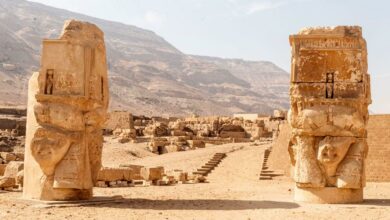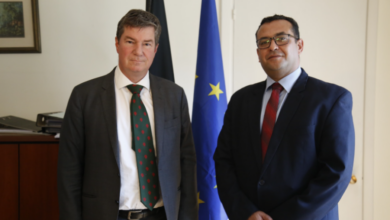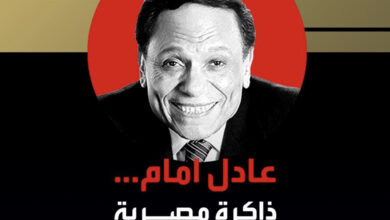
Following its award-winning spree at the Third Doha Tribeca Film Festival, the 2012 Berlinale and the 15th Ismailia International Film Festival, Namir Abdel Messeeh took his debut feature documentary “The Virgin, the Copts and Me” on a round of public screenings in Egypt in July.
“The Virgin, the Copts and Me” is a playful film. It peels off its many layers gradually and smoothly until you reach its very core; a process that, despite sharp narrative turns and geographical leaps, helps align viewers with Abdel Messeeh’s logic.
The film’s few online synopses set us up for an investigation of the Virgin Mary apparitions in Egypt led by the filmmaker himself, an Egyptian born in France to a migrant Coptic family. The investigation is sparked by an amateur videotape that his family receives, recording an alleged apparition in their hometown, Sohag.
The controversial apparitions have a phenomenal aspect when it comes to Egypt, often associated with notions of spiritual salvation at times of political, economic and social hardships. The famous 1968 apparition followed the 1967 defeat, and that of 2006 came at a similar economic and political low. But the first few minutes of the film penetrate any predetermined expectations.
The opening credits include a pun-intended list of crossed-over prestigious production companies that did not fund the film, followed by a voice message from Abdel Messeeh’s producer wondering, “Is it about the Virgin, the Copts or you?” The comically edited family scenes, heightened by a skeptical voiceover capturing Abdel Messeeh’s humorous stance on the whole issue, also indicates from the very beginning that the film is not going to be your rigid, state-TV-style scientific documentary, nor is it interested in shoving information down viewers’ throats.
“The Virgin, the Copts and Me” goes on to follow the filmmaker’s trip from France to Egypt. Faced with uncooperative church officials and a lack of concrete evidence, Abdel Messeeh decides to decamp to his mother’s home village in Upper Egypt to meet a branch of his family he has not seen in 15 years, using the alibi of covering a Virgin Mary moulid. A moulid is a celebration of a saint’s birthday.
This unplanned detour costs him the financial support of his producer and cues the introduction of the filmmaker’s mother, Siham, as the new producer. It also signals warm and heartfelt sequences that explore themes of family, faith and the power of cinema, as relatives and friends decide to take part in reenacting an apparition to help “complete” the documentary.
Questions about the premise are raised throughout the few sharp turns the documentary takes. But one thing is for sure: The audience still follows, mostly because of the genuineness of all of the film’s characters, particularly Siham and her extended family members in Sohag. This is appreciated even more as the scenes reveal another layer of the film that is mostly scripted.
Seeing this documentary out of context might instigate a critique of the film’s fluctuating premises and orchestrated scenes. But, in Egypt, it has been generating different reactions. Indeed, it could not have come at a more relevant juncture, with the current peak of polarization following a year of post-revolutionary sociopolitical turmoil, and years of sectarian strife. The public screening of “The Virgin, the Copts and Me” in Egypt is more a social litmus test than an artistic event.
At a table in downtown Cairo’s Cafe Riche, Abdel Messeeh and his parents discuss the film as it is screened in the next room.
“One Egyptian critic saw the film in Doha,” Abdel Messeeh recalls. “He told me he would make sure it never saw Egyptian screens, as he found it heretic.”
Similarly, the reactions of Egyptian Coptic viewers have varied according to the setting.
“A full Christian screening by a friend of mine generated a lot of laughter. Paradoxically, the same film caused anxiety and dismay when screened to a mixed audience of Muslims and Christians,” he says.
Whether Abdel Messeeh’s decisions on how to tackle the sensitive issue were made consciously, or resulted from his position as a relative outsider to the local scene, the film offers fresh blood to the often reactive discourses used in dealing with such topics.
Scenes such as the villagers’ disapproval of the “too revealing” Western version of the Virgin Mary’s photos, or the filmmaker’s instant response to not finding a girl suitable to play the Virgin’s role in the reenactment at the local church — asking, “Can we get a Muslim girl to do the part?” — generate laughter. But they also manage to get the audience to penetrate layers of stereotypes and schisms.
This seemingly naive probing finds a certain balance between being provocative and stimulating, but this is obviously not true for all audience members.
Abdel Messeeh’s father recounts how an audience member at the Cimatheque screening in downtown Cairo accused the film of exploiting and mocking the “poor,” and possibly “naive,” village people.
“I never felt this gap that would allow for exploitation at any point while shooting the village scenes,” says Abdel Messeeh. “They understood very well what I was doing, but it seems that this is something that some viewers did not get, which speaks of a [classist] social code in Egypt that I have not figured out yet. I have not encountered such feedback anywhere else.”
This class-based tension is not the main concern of the film. But as Abdel Messeeh reveals another layer of the development process, it makes more sense.
“The virgin apparitions were not there in the beginning. My main motive was my passion to film something in this village with these people. I was not sure what it was, but I went along with my intuition. This final structure came about after two years of shooting, editing, writing and shooting again,” he says.
One of the film’s most interesting scenes comes at the end of the reenactment sequence, when the villagers helped by acting and working behind the scenes of the film, within the film.
“At a certain point, we were not sure which one was the main film. We had two cameras, but we were perplexed between shooting the apparition reenactment and filming the making of it,” Abdel Messeeh explains. “It took us a whole day to realize that it is not just about realizing the apparition, but about the whole experience we were having with my family — all the behind-the-scenes interactions.”
In the filmmaker’s quest to follow his intuition, the documentary stumbles upon an interesting moment of enlightenment, summoning faith and collective consciousness: a scene where everyone gathers in front of the erected white sheet in the village to watch a projection of the finished shots of the apparition reenactment.
The devout absorption on people’s faces not only resonates with archival images of people from the actual apparition, but also with us as audience members experiencing this state of elation, despite both parties’ rational awareness of the fabricated nature of the projected images.
Fact or fiction, the main strength of the film lies in its devotion to reflecting core human values like faith, rather than investigating practices and phenomena. Evidently, projecting such values — which transcend sectarian and class perceptions — confuses those with extremist perspectives that use discrimination as a base of self-preservation. The film also reminds the rest of us of inimitable characteristics of the Egyptian identity that seem in danger of perishing.
This piece was originally published in Egypt Independent's weekly print edition.





